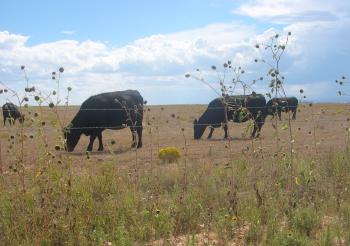Drought Management Webinar Series
Three-Part Webinar Series
With drought conditions everywhere across New Mexico, with seemingly limited relief in sight, producers are forced to make critical management decision, some sooner rather than later. NMSU Extension Animal Science & Natural Resource Specialists hosted a webinar series discussing production decision strategies in managing through current and extended drought conditions.
Part I: Considerations of Early Weaning for Calf & Cow
July 21, 2020
Weaning Management in Drought
Craig Gifford, NMSU Extension Beef Specialist, cgifford@nmsu.edu
The immediate impacts of weaning calves earlier than normal for sustaining a limited forage base will be discussed. If managed appropriately, removing calves early can be an effective tool to mitigate impacts of drought.

Selecting for Feed Efficiency to Help Manage Through Drought
Marcy Ward, NMSU Extension Livestock Specialist, maward@nmsu.edu
Herd reduction due to drought is one of the biggest threats towards a rancher’s ability to stay in business. Combining good record keeping, selecting females that are older at weaning and are moderate framed, and using bulls that carry desirable genetic and performance traits in efficiency could potentially help alleviate the need of expansive de-stocking during times of drought.
- Herd Management & Drough Slides (PDF)
- New Mexico Drought Resources
- NIDIS | U.S. Drought Portal
- Beef Cow BCS (Created by CRYSTALYX) | App Store for iPhone & iPad
- Beef Cow BCS (Created by CRYSTALYX) | Google Play Store
Part II: Range Monitoring During Drought & Late Season Monitoring
July 23, 2020
Casey Spackman, NMSU Extension Range Specialist, spackman@nmsu.edu
A basic synopsis and tutorial on range monitoring; why monitoring is even more important during drought conditions; and, how the Rapid Assessment Methodology (RAM) can save time but still provide essential information of rangeland conditions, assisting producers in decision making.
- Drought Management & RAM Slides (PDF)
- How to Build a Range Monitoring Kit (Video)
- Rapid Assessment Methodology [RAM] Tutorial (Video)
- Rapid Assessment Methodology for Proactive Rangeland Management (PDF)
- Monitoring Rangelands in New Mexico: Range, Riparian, Erosion, Water Quality, and Wildlife
- Data Entry, Organization and Analysis for Rapid Assessment Methodology
- RAM Monitoring Kit
- RaDAR Data Worksheet (PDF)
Wildfire Preparedness for Your Home & Ranch
Doug Cram, NMSU Extension Forestry & Fire Specialist, dcram@nmsu.edu
Do you have a wildfire plan? During these exceptionally hot and dry days, all that fuel (grasses, shrubs, trees, weeds, woodpiles) in your yard and pasture is drying out and primed to burn down your house, barn, and fences. Tune in to learn simple tips you (and your kids) can do to reduce your risk (besides wearing a mask) during these droughty days.
Part III: Calf Vaccination Protocols
July 29, 2020
Craig Gifford, NMSU Extension Beef Cattle Specialist, cgifford@nmsu.edu
Normal weaning vaccination programs and some special considerations during times of drought to keep calves healthy as they transition to stocker or grower operations will be discussed.
- Drought: Herd Management & Vaccination Considerations Slides (PDF)
- Cattle Vaccination & Immunity, Guide B-222
- Cattle Vaccination Guidelines, Guide B-223
- Cow Herd Vaccination Guidelines, Guide B-224
Fall Bull Management & Trich Ruling Update
John Wenzel, NMSU Extension Veterinarian, jwenzel@nmsu.edu
Bull management doesn't start and end in the spring before turn out. Vaccination, body condition, and overall health need to be monitored in bulls in the fall as well. A review of the latest updates in New Mexico's regulations related to Trichomoniasis will also be discussed.
Range Monitoring During Drought & Late Season Monitoring
Casey Spackman, NMSU Extension Range Specialist, spackman@nmsu.edu
Tools for compiling data regarding rangeland conditions; interpreting the data; and how to use the information for critical management decisions both short term, reduced stocking rates, and developing long-term goals.